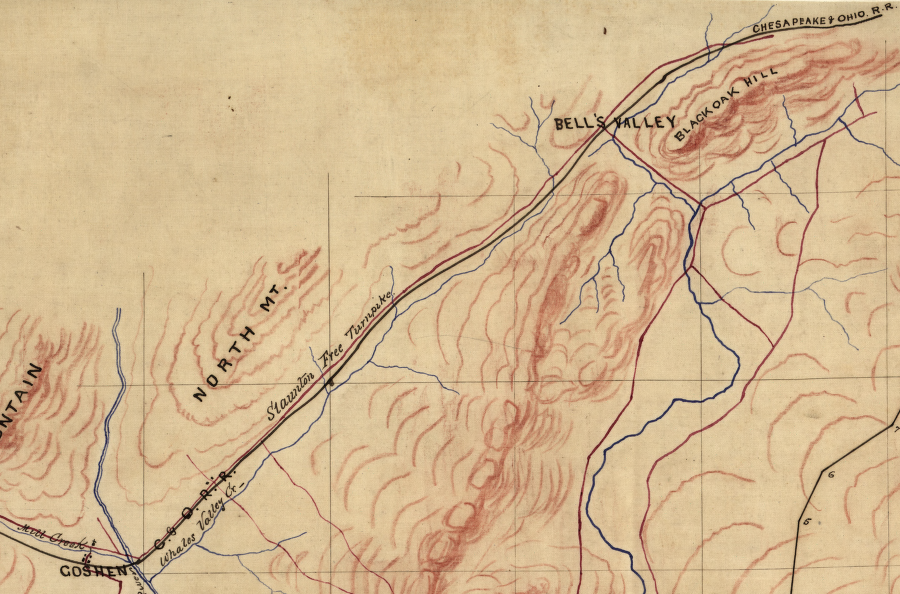Staunton-Parkersburg Turnpike

the Staunton Free Turnpike paralleled the railroad, as they both crossed Little North Mountain west of the Shenandoah Valley
Source: Library of Congress, Copy Septr. 1879 (G.R.F) of map (by C. W. Oltmanns, 1879)
The General Assembly authorized $150,000 for construction of the Staunton-Parkersburg Turnpike on March 16, 1838. The legislature specified that the turnpike:1
- ...shall no where exceed a grade of four degrees, nor shall be more than twenty feet wide, nor less than fifteen feet, exclusive of side ditches.
The principal engineer for the project estimated the turnpike would be 220-230 miles long. To manage cost, he recommended exceeding the limit of 4 degrees for the grade in a few places:2
- The law requires the grades not to exceed 4°. Although I have ever advocated the lowering of the maximum grade formerly fixed by law, still, in this instance, I would wish to be allowed some latitude beyond 4°. We have met with some few cases where this grade increased greatly the difficulties of locating and cost of making the road, and a small addition of between a quarter and a half would have been better adapted to the peculiar formation of the ridges: indeed, on the Shenandoah mountain, I found it impracticable to grade at 4° without cutting 15 feet deep, at great expense, through its rocky top.
Parkersburg was already linked to Winchester via the Northwestern Turnpike, while the James River and Kanawha Turnpike provided connections further south of Staunton. Construction of the Staunton-Parkersburg Turnpike was done in part by Irish laborers imported to provide a labor force in the sparsely-populated area. The road was completed in 1847. Modern US 250 follows much of its route. The James River and Kanawha Turnpike is traced by modern US 60, and the Northwestern Turnpike is now modern US 50.3
Links
References
1. "On This Day in West Virginia History," West Virginia Archives and History, https://archive.wvculture.org/history/thisdayinwvhistory/0316.html; "Staunton-Parkersburg Turnpike," Acts of the General Assembly of Virginia, passed at the Session of 1838, Thomas Ritchie, 1838, https://archive.wvculture.org/history/transportation/stauntonparkersburg01.html (last checked March 17, 2022)
2. "Twenty-Third Annual Report of the Board of Public Works to the General Assembly," Shepherd and Colin, 1839, pp.20-21, https://archive.wvculture.org/history/transportation/1839publicworks.pdf (last checked March 17, 2022)
3. "March 16, 1838: Construction of the Staunton & Parkersburg Turnpike," "Time Trail, West Virginia" March 1998 Programs, West Virginia Archives and History, https://archive.wvculture.org/history/timetrl/ttmar.html#0316 (last checked March 17, 2022)
Transportation: From Feet to Teleports
Virginia Places

